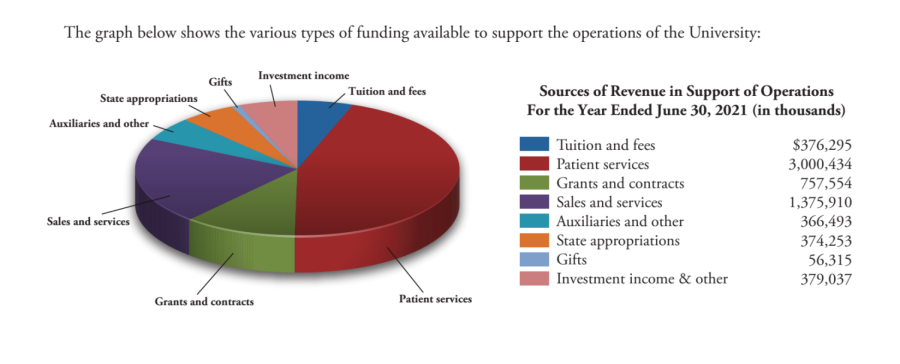Salaries, Services and Possible Savings: Breaking Down Tuition and Fees
(Photo by Langley Hayman | The Daily Utah Chronicle)
September 2, 2022
Tuition costs are continually on the rise in the United States. According to the National Center for Education Statistics, the average tuition and fees of public four-year institutions were 13% higher in the 2019-20 academic year than 2010-11. But what does tuition actually pay for?
Salaries for Faculty and Staff
Mark Winter, the associate vice president for budget at the University of Utah, said tuition is a source of funds that the university uses solely for the purpose of educating students. Most of that money goes to paying the salary and benefits of teaching faculty and support staff.
“About 80% of [tuition] is for salaries,” Winter said. “That could be anything from faculty to TAs to secretaries to administrative assistants — it could even support some of the environmental service workers as well.”
Winter said there are many factors that determine the pay rate of a faculty member, but the biggest is their field, with “medical, engineering, science and business faculty” being the highest paid.
Winter described the remaining 20% of tuition broadly as “operating funds,” which cover a wide range of day-to-day needs for the university including office supplies, travel to professional conferences, technology for teaching and purchasing lab supplies.
Because the U is a large entity, encompassing a number of different facilities and organizations, Winter said it receives funding from various sectors, with tuition being one small fraction of the total amount.
“The university is a big organization, we spend over $5 billion a year and tuition and fees are about $400 million of that, so it’s a fairly small piece,” Winter said.
According to the U’s 2021 financial report, around $376 million in revenue came from tuition and fees. This amount, along with the $374 million appropriated by the state legislature, is the funding available to fulfill the U’s educational mission of paying for faculty and staff salaries.
“Higher education uses something called fund accounting, and depending on the source of the funds is really how they’re used … so tuition funds and state funding that’s provided for education, legally, we can only use them to teach and educate students,” Winter said.
Other sources of funding include patient services, generated by the U Hospital, as well as athletics, which are included in the sale and services or auxiliaries category.
Winter explained fund accounting as an accounting system where the revenue generated by a certain source can only, by law, be used to fund the same source. For example, tuition and state funding cannot be used to support athletics — they have to generate their own funding to support themselves. Conversely, funding generated by athletics can only be used to support athletics, not to fund other student services.
Matching the State Legislature and Evaluating Current Needs
Winter said the amount set for tuition is evaluated every year in a process that takes several months that beginning with the amount of money pledged by the state legislature, which must be matched by the university.
“It’s a long process that starts [around] December, and a lot of it is driven by what the state legislature decides to do for funding,” Winter said. “We’re required to fund 25% of any salary increase that the state approves for us.”

In the 2022 general session, the state legislature approved a 3.5% salary increase for state employees. In order to fund 25% of this increase, the U proposed a 4.8% increase in tuition, which was approved by the Utah Board of Higher Education in March, according to At The U.
The U’s tuition is structured so the increase approved for each year adds on to the tuition of the previous year. There is a variety of tuition structures used by colleges, such as providing a flat rate to students at the same tuition they paid when they began their degree, or plateau tuition, where the college charges a certain tuition amount per hour up to a number of credits, after which there is no charge for additional credits.
Winter said the U has considered other options, but did not feel they promoted faster graduation, which is a major goal because helping students graduate faster is the “easiest way to keep college affordable.”
After the state legislature’s funding is taken into account, Winter said the U considers additional needs they may have at the time. A few years ago, that meant fulfilling a need to hire more academic advisors.
Right now, it’s addressing the salary freezes and unfilled positions caused by the COVID-19 pandemic. During the Truth in Tuition hearing held by university leaders in March, Jason Atuaia, then executive director of budget and finance, provided context to the post-pandemic situation.
“Hiring and salary freezes were implemented early in the pandemic,” Atuaia said. “No salary increases were given during the year 2020, and this culminated to an open job position count of 587.”
Winter said costs during the pandemic were greater than usual because of the cost of implementing remote learning, including the funds spent on personal protective gear for students, cameras and software to help move classes to an online format and maintaining employees.
“You still have the same number of faculty teaching the courses, the same number of students who are TAs that are grading courses, you’re just not in a physical building,” Winter said. “We didn’t want to lay off our employees … so we tried to basically shut things down while keeping things running without spending any extra money.”
Recognizing the struggle of students during this time, Winter said the U did not increase tuition and refunded fees for facilities such as the gym that students were unable to take advantage of at the time.
Winter said the U tries to keep yearly tuition increases low, but a 0% increase is not possible.
“We are very aware of the expense to students and so we are not raising tuition wildly and crazily,” Winter said. “If we could, we would provide tuition at a 0% increase every year. The reality is we can’t afford to do that any more than other businesses can afford to give away something for free.”
Differential Tuition
Besides the general increase in tuition, students could also see an increase in their differential tuition, which is the amount charged on top of base tuition that varies depending on a student’s major.
“It was started because teaching in a school of medicine is more expensive than teaching in fine arts, so instead of charging all students extra funding, those students that consume the extra resources pay more,” Winter said.
In order for a college to charge differential tuition, it must submit information supporting its justification and be approved through voting by the students of that college.
Differential tuition cannot be spent on faculty salaries. The funds must be spent in areas explicitly benefitting students. Winter used the College of Science as an example where differential tuition is justified because it’s a college with high resource usage.
“Math courses are required for everybody and there’s usually a chemistry or biology lab that they’re taking and so the [College of Science has] extra costs just teaching students that are humanities students or engineers,” Winter said. “Most of their differential is used to support TAs.”

What Mandatory Fees Include
In addition to tuition, another fee that appears on undergraduate students’ accounts is the charge for mandatory fees.
These fees fund many services such as the Arts Pass program, maintenance of the Student Life Center and transportation fees for campus shuttles and UTA passes. A detailed breakdown of the dollar amount given to each category can be found on the U’s Office of Budget and Institutional Analysis website.
Beginning next year, the union building fee of $2.35 per semester will be eliminated. The separate $30 student success fee, which Winter said was implemented as a short-term fee to allow the U to hire necessary personnel at the time, will be phased out in a couple of years.
Mandatory fees at the U have been subject to scrutiny in the past. A state audit from 2020 criticized the fees for charging students for things that should have already been covered by tuition.
A state audit from 2021, which focused on course fees at Utah’s eight public colleges, criticized them for generating excess revenue with the fees instead of breaking even, and for lacking detailed descriptions of what the fees were being used for.
Winter said the mandatory fees at the U are evaluated every year by a committee made up of nine people, five of whom are students and four of whom are from the U’s administration. The student chair of the committee is appointed by the president of the university and is usually filled by the student body president.
As enrollment numbers have increased in the past couple of years at the U, Winter said it will become necessary to weigh between additional tuition dollars and additional need for resources.
“Part of what we have to figure out is, how far can enrollment go up before we have to hire another instructor?” Winter said. “We really have to work hard to find where … these bottlenecks [are] going to be that we need to provide resources.”








